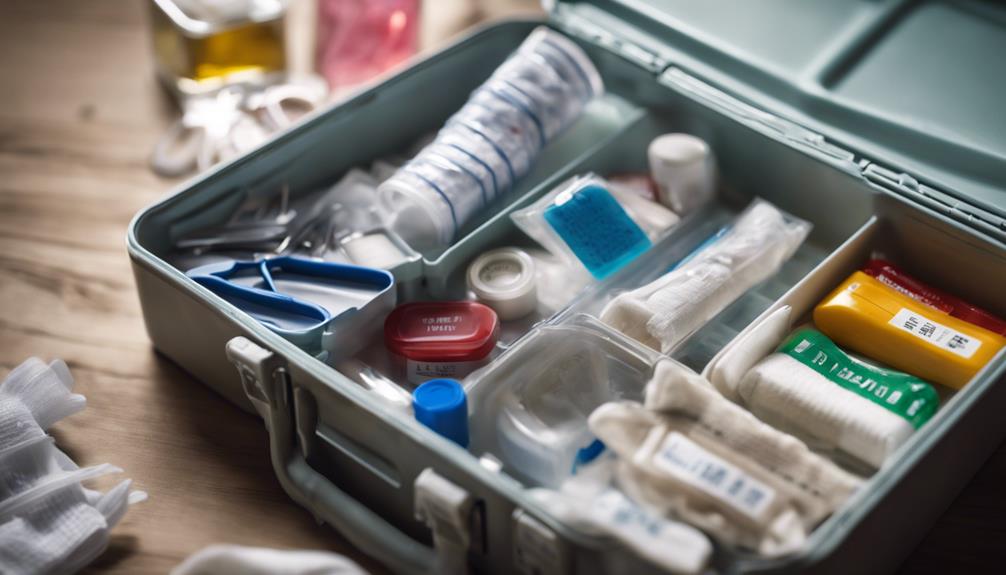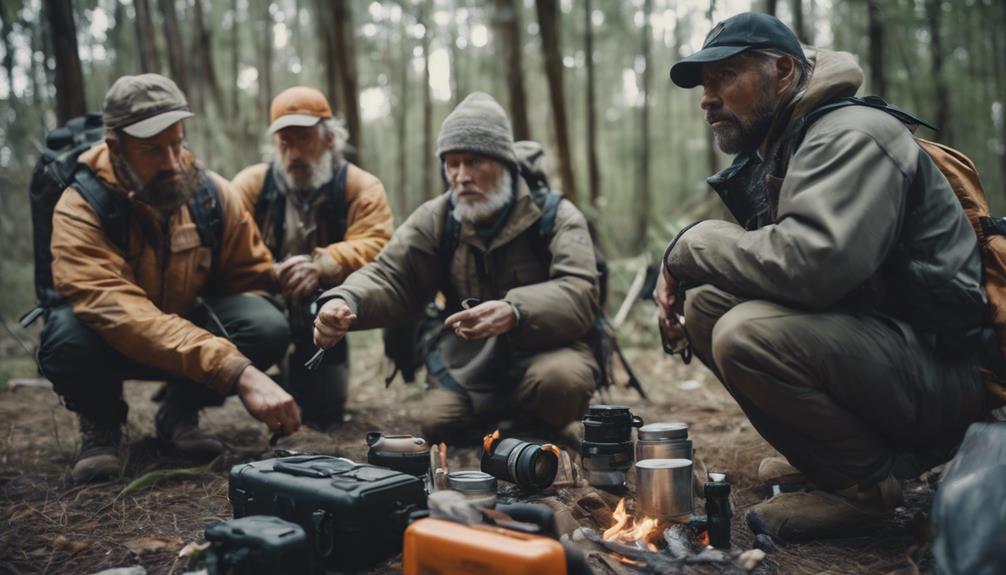For your wilderness adventures, essential fishing kits are a must. They provide a dependable food source when supplies run low. Your kit should include items like fishing lines, hooks, and bobbers. Look for compact options like the Best Glide Survival Fishing Kit or the portable Readyman Wilderness Card. It's important to choose durable, lightweight gear that's easy to set up. Mastering both active and passive fishing methods will increase your catch rates. Don't forget to take safety precautions and practice sustainable fishing. Exploring more options and techniques can enhance your outdoor experience even further. Consider investing in a quality tackle box to keep your fishing gear organized and protected. Researching the best spots for fishing in the area can also improve your chances of a successful catch. Additionally, to ensure your safety during wilderness adventures, consider bringing along top murs radios to stay connected with your group and have access to emergency communication if needed.
Key Takeaways
- Reliable fishing kits provide essential gear like lines, hooks, and bobbers for wilderness survival and self-sufficiency.
- Compact options, such as the Best Glide Survival Fishing Kit, ensure portability and versatility in outdoor adventures.
- The Readyman Wilderness Card offers ultra-portability, fitting easily in a wallet for convenient access.
- Mastering passive fishing methods, like trotlines and limb lines, enhances catch rates without constant attention.
- Regular maintenance and inspection of fishing gear ensure functionality and readiness for any wilderness fishing scenario.
Overview of Fishing Kits

When you venture into the wilderness, having a reliable fishing kit can make all the difference between a successful outing and going hungry.
These kits are essential for survival, providing a dependable food source when other options might be limited. A well-equipped fishing kit enhances your outdoor experience, promoting self-sufficiency and reducing reliance on pre-packaged food.
Essential gear typically includes fishing lines, hooks, and bobbers, which help you implement effective fishing techniques. Familiarizing yourself with passive methods like trotlines and limb lines requires less effort and can improve your catch rates across various environments.
Ultimately, investing in a good fishing kit isn't just about catching fish; it's about ensuring you're prepared for whatever the wilderness throws your way.
Recommended Fishing Kits

Choosing the right fishing kit can greatly enhance your wilderness adventures. The Best Glide Survival Fishing Kit is a top choice, offering compactness and essential gear for versatility.
If you want something ultra-portable, consider the Readyman Wilderness Card; it fits right in your wallet, making it perfect for emergencies.
For multitasking while fishing, the Mechanical Fishers YoYo and Southern Survival Limb Lines streamline your efforts, allowing you to increase efficiency.
Each of these kits is designed to keep you prepared and ready for any fishing situation.
Remember to regularly inspect and maintain your gear to guarantee functionality, so you're always equipped when it's time to catch your next meal in the wild.
Selection Criteria

Selecting the right fishing kit involves evaluating several key features to guarantee it meets your wilderness needs. Focus on durability, weight, and functionality when making your choice. A lightweight kit is easier to carry, while durable gear withstands harsh conditions. Look for user-friendly tools that facilitate quick setup, enhancing your efficiency in survival scenarios. Additionally, consider multi-purpose functionality to save space.
| Feature | Importance | Example |
|---|---|---|
| Durability | Withstands harsh conditions | Stainless steel hooks |
| Weight | Enhances portability | Compact rod and reel combo |
| Ease of Use | Facilitates quick setup | Tangle-free fishing lines |
| Multi-functionality | Saves space and weight | Tools that double as knives |
Effective Fishing Techniques

Mastering effective fishing techniques can greatly boost your success in the wilderness. Start by familiarizing yourself with both active and passive methods.
While active fishing, like casting or trolling, requires your attention, passive techniques such as trotlines and limb lines can yield results with minimal effort. Learn to tie secure knots and properly bait your hooks to maximize your catch.
Stealth is essential; approach your fishing spot quietly and be patient. Experiment with different lures and baits to see what attracts fish in your area.
Always be mindful of local fishing regulations and adjust your techniques based on water conditions and fish behavior. Adaptability is key, so stay observant and ready to tweak your methods as needed for ideal results.
Safety Considerations

When heading out for a fishing adventure in the wilderness, prioritizing safety is essential to guarantee an enjoyable and successful experience.
Start by checking local weather conditions to avoid hazardous situations. Always carry a well-stocked first aid kit to address potential injuries and make sure you stay hydrated throughout your outing.
Inform someone about your fishing location and expected return time; this simple step can make a significant difference in an emergency.
Be mindful of wildlife and practice Leave No Trace principles to protect natural habitats.
Finally, familiarize yourself with local fishing regulations to fish responsibly.
Maintenance Tips

After ensuring your safety during wilderness outings, maintaining your fishing gear is key to a successful experience.
Regularly inspect your rods, reels, and lines for any signs of wear or damage. Clean your gear after each use to remove dirt, salt, or debris, which can lead to corrosion.
Store your tackle in a dry, cool place to prevent rust and deterioration. Replace any lost or damaged hooks and lines promptly to avoid losing your catch.
Additionally, check your bait and tackle for freshness before each trip.
By keeping your equipment in top shape, you'll enhance your chances of a successful fishing experience and enjoy your time in the great outdoors.
Don't overlook maintenance—it's as vital as the fishing itself!
Sustainable Fishing Practices

Sustainable fishing practices are essential for preserving aquatic ecosystems and guaranteeing that fish populations remain healthy for future generations.
To practice sustainable fishing, always be aware of local regulations and catch limits. Use barbless hooks to minimize harm to fish, and practice catch and release whenever possible.
Avoid overfishing by only taking what you need and selecting smaller, abundant species. When fishing, stay clear of breeding areas to protect vulnerable populations.
Additionally, avoid using harmful bait or gear that could damage habitats. By following these guidelines, you not only contribute to the health of the environment but also enhance your fishing experience.
Frequently Asked Questions
What Types of Fish Can I Catch With These Kits?
You can catch various fish using these kits, including trout, bass, catfish, and panfish. By adapting your techniques and bait to the specific species and local conditions, you'll maximize your chances of success.
Are Fishing Licenses Required in Wilderness Areas?
Yes, fishing licenses are generally required in wilderness areas. You should always check local regulations before fishing. It helps guarantee conservation efforts and keeps you compliant with the law, avoiding potential fines or penalties.
How Do I Store Bait for Longer Freshness?
Did you know that properly stored bait can last up to three times longer? To keep bait fresh, store it in a cooler with ice or use a bait bucket with aeration to maintain ideal conditions.
Can I Use Fishing Kits in Freshwater and Saltwater?
Yes, you can use fishing kits in both freshwater and saltwater. Just make certain your gear's suitable for the specific environment. Check hooks, lines, and baits to optimize your chances of a successful catch in either setting.
What Should I Do if I Catch a Fish I Can't Eat?
If you catch a fish you can't eat, don't panic. Investigate its species; some may be unsafe. Release it gently back into the water, ensuring minimal harm, or consider sharing it with others who can consume it.
Conclusion
In the wild, the thrill of the catch contrasts with the calm of the water. With the right fishing kit, you're not just surviving; you're thriving. Equip yourself to embrace both challenge and tranquility, turning every outing into a memorable adventure. Remember, each line cast is a step toward self-sufficiency, and every fish caught is a proof of your skills. So gear up, get out there, and savor the balance of nature and nourishment.










